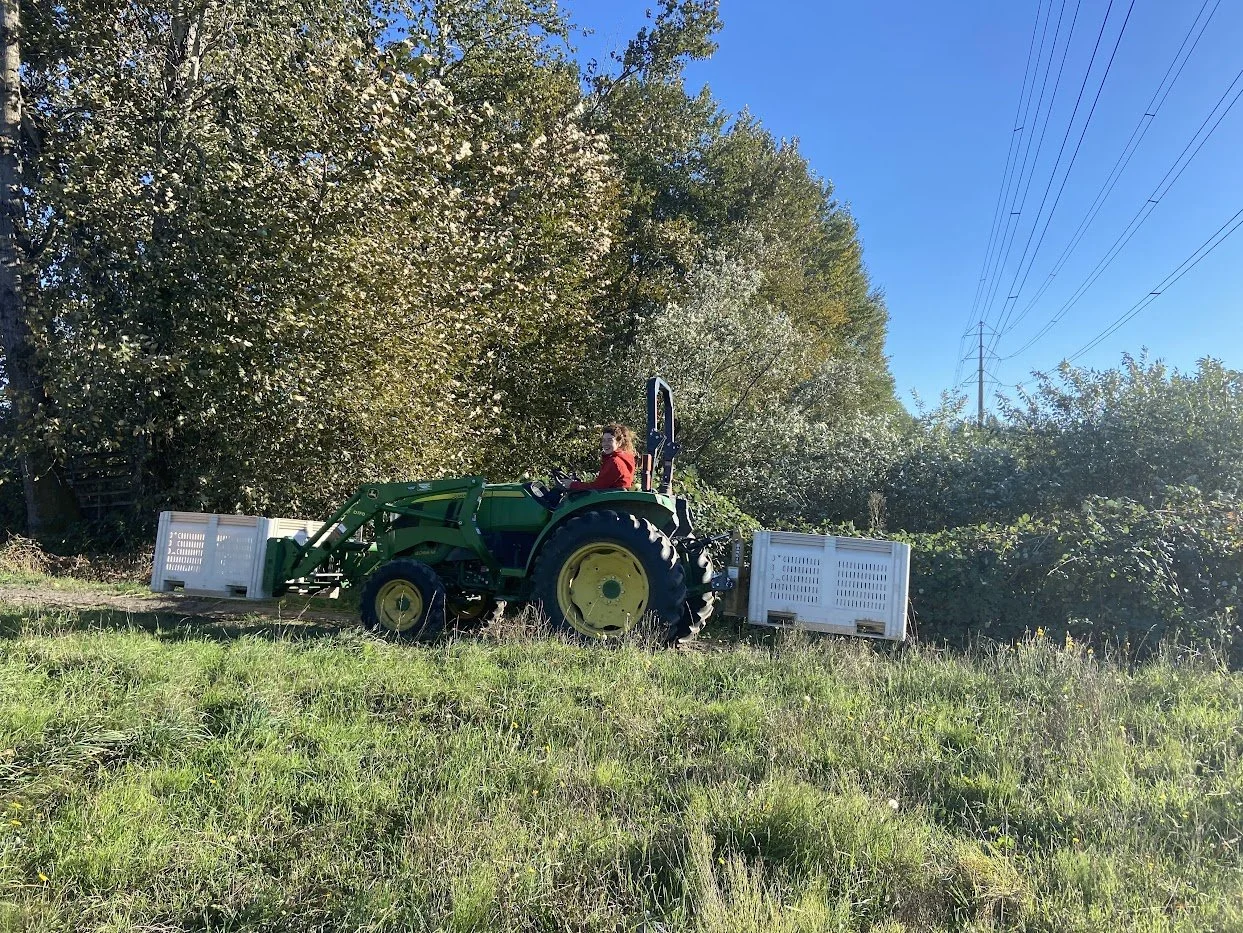Fall 2025 #2/10: Red Beets, Red Kuri & Red Apples
This year’s root vegetable harvest began in earnest today. On a cool, blustery afternoon Claire, Kelly and Mia got the party started with several hundred pounds of Red Beets. There are more beds to go, but they filled the back bin that you see on that tractor in a matter of hours, and that’s worth applauding. The work gets heaaaavy this time of year. Some of those beets will go to the CSA this week, and the rest will be washed, trimmed and bagged up for storage, which is the rhythm we will follow for several weeks until we’ve picked and washed everything that we can fit in our little root cellar.
Along with those Red Beets, this is a great week to dip into our stash of Red Kuri Squash. Red Kuri might be the most stunningly orange Winter Squash of them all. It is a teardrop shaped Japanese Hubbard-type that is as bold on the inside as it is outside, and it imparts that same rich orange color and rich nutty flavor to whatever you’re cooking up. Simply put, it is one that I like to show off, and my favorite way to do that is with Alice Waters’ Red Kuri Squash Soup. It is my back pocket recipe for any kind of squash soup, crispy fennel and all. Red Kuri also has a fairly thin skin, so if you’re looking to roast it in gorgeous little wedges, you can get away with leaving the skins on, especially since we’re pulling some of them on the earlier side of the curing process.
About this term, curing…ie, the reason why ALL of the kinds of squash we grow aren’t already out for sale. Growing for the long haul seasons means that we take a lot of fussy little steps to keep our storage vegetables in great shape for us all to eat through the Fall and Winter. We cure our Winter Squashes in order to help them harden slightly and let the flavor develop a bit so that we can enjoy them over the next several months. If we were to leave them in the field, exposed to moisture and frost, they would be more prone to rot, and in the case of those Butternuts we’re all looking forward to, might not taste as great. (The exception to this rule is Acorn Squash--it doesn't store as well as other varieties, regardless of curing. So, that is why we tend to lead off with that variety to start the season). As for the rest, we've packed them (and in the case of this year STACKED them) into a warm room that we heat up to 70 degrees over the course of at least a week and a half, after which point we will drop the temp down and hold them at as close to 50 degrees and 50% humidity as we can. This way, you can store your squash on a shelf in your garage or whatnot between now and about March, enjoying them at your own pace.
We’re up to 13 varieties of incredible Washington Organic Apples in house this week, and the CSA will be mixing and matching two of last year’s favorite red apple varieties —Crimson Crisp (sweet, deep-red and snappy) and NY 428 (which is a cross of two of my personal favorites—Empire & Northern Spy).
Many Thanks!
Katie
PS: I will continue to post reminders until we get closer, but we will be CLOSING (EARLY) at 6:00pm on Tuesday, October 28th & Tuesday, December 9th. Thank you for your understanding—
IN THE FARMSHARES THIS WEEK:
Red Kuri Squash
Broccoli Shoots or Shishito Peppers
Fennel
Red Beets
NY 428 & Crimson Crisp Apples
RECIPES & SEASONAL TIPS
RED KURI SQUASH SOUP WITH CRISPY FENNEL - Alice Waters
ROASTED SQUASH WITH YOGURT & SPICED BUTTERED PISTACHIOS - Alison Roman
WINTER SQUASH BHARTA- Sohla El-Waylly
RED KURI SQUASH CURRY WITH CHARD - Naturally Ella
SHEET-PAN CHICKEN WITH APPLE, FENNEL & ONION - Colu Henry
BEET-and-APPLE SALAD - George Mendes
WINTER BEET & POMEGRANATE SALAD WITH MAPLE CANDIED PECANS & BALSAMIC CITRUS DRESSING - Half-Baked Harvest
VEGETARIAN BORSCHT (pressure cooker!)- Feasting at Home
APPLE SHARLOTKA- Smitten Kitchen


